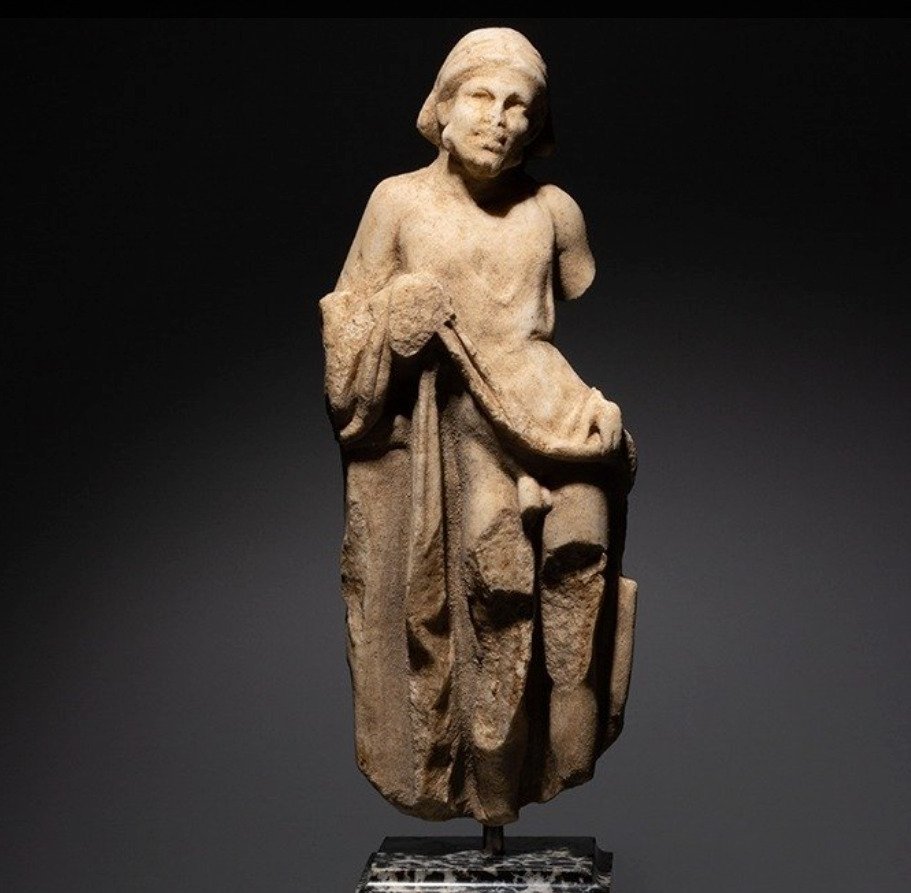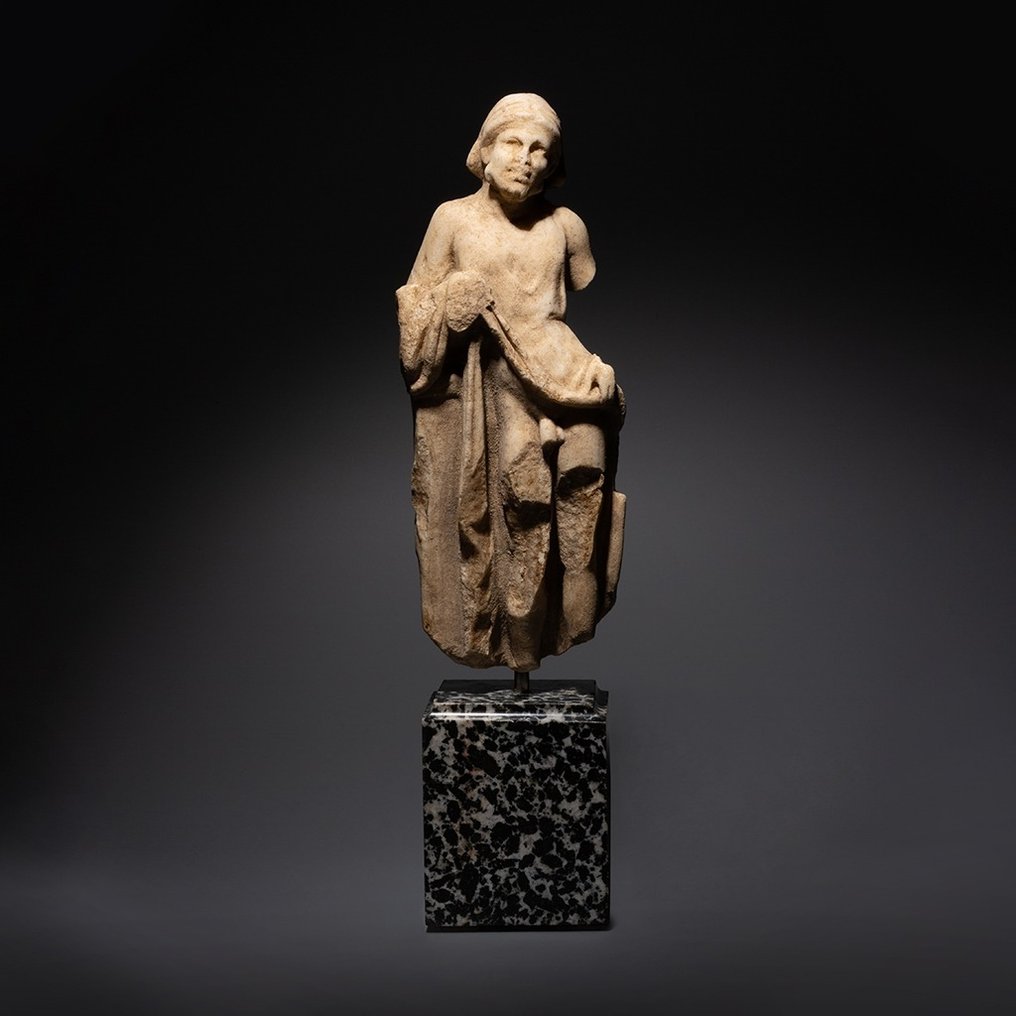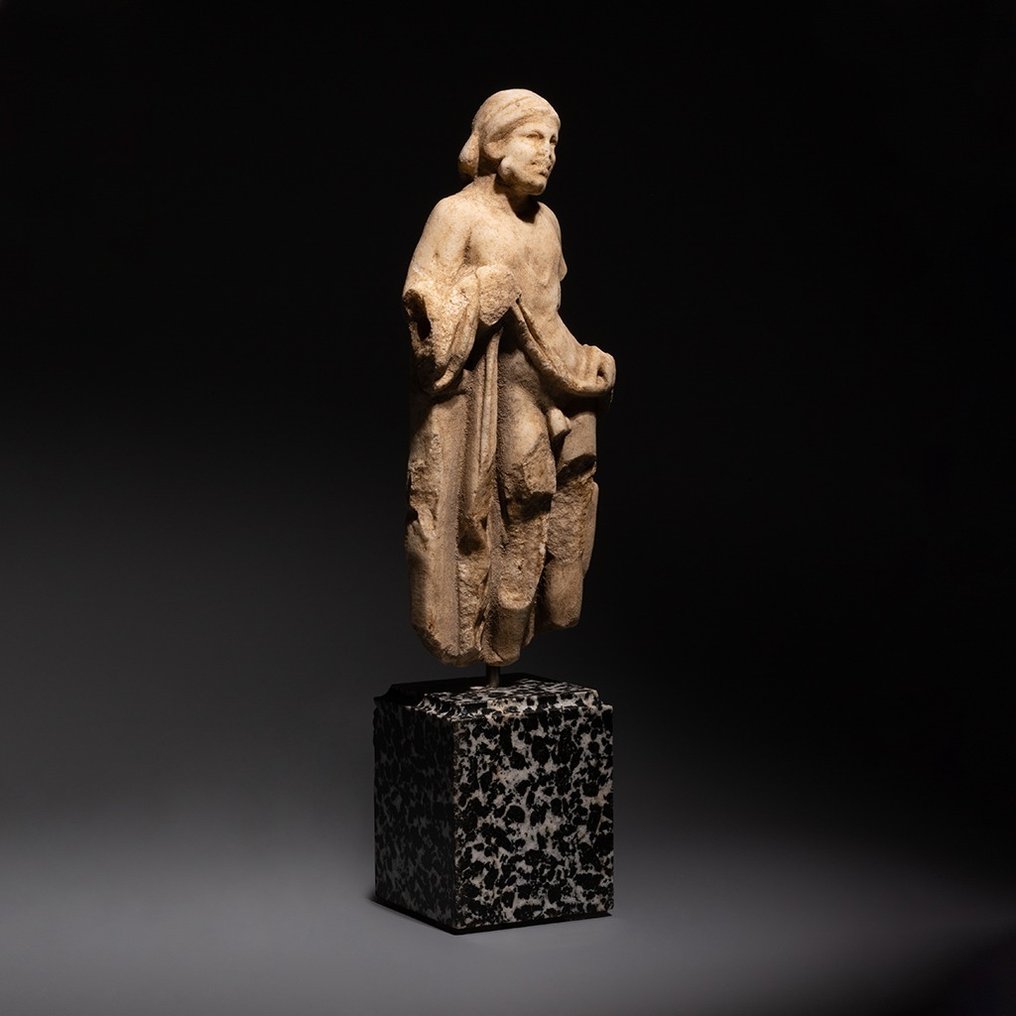Great object. Really beautiful. Quick delivery. Excellent.
Übersetzung ansehenAltgriechisch Marmor Priapus-Skulptur. 2. - 1. Jahrhundert v. Chr. 24 cm hoch. Spanische Exportlizenz
Nr. 88173087



Priapus sculpture.
- Important! -
- Unique! -
Greek Hellenistic, 2nd - 1st century BC
Marble
24 cm Height (without stand)
PROVENANCE: Private collection, London, acquired 1960s - 1980s.
CONDITION: Unrestored, as found. Untouched natural patina.
DESCRIPTION:
Depicted standing, resting on a pillar, in the act of lifting the robe, discovering the genitals; the head is wrapped in a drape and a flap-like extensions beneath the chin representing a cock’s wattle. This rather unique figure of Priapus finds some paralels on groups such as the statue in Berlin which shows the head of the maenad, found before 1872 on the Quirinal near the Piazza Barberini, and a second in the National Museum at Athens where the head of Priapus is preserved. Cf. M. B. Comstock and C. C. Vermeule, Sculpture in Stone, The Greek, Roman and Etruscan collections of the Museum of Fine Arts Boston, Boston, 1976, p. 127, no. 196, for a similar Graeco-Roman group.
We did not found direct paralels for this sculpture since it was never copied in mass scale in roman times, that fact makes this sculpture very unique and unparalllel and a new form of the known corpus of images of Priapus.
Priapus was described in varying sources as the son of Aphrodite by Dionysus; as the son of Dionysus and Chione; as perhaps the father or son of Hermes; or as the son of Zeus or Pan. According to legend, Hera cursed him with inconvenient impotence (he could not sustain an erection when the time came for sexual intercourse), ugliness and foul-mindedness while he was still in Aphrodite's womb, in revenge for the hero Paris having the temerity to judge Aphrodite more beautiful than Hera. The other gods refused to allow him to live on Mount Olympus and threw him down to Earth, leaving him on a hillside. He was eventually found by shepherds and was brought up by them.
Priapus joined Pan and the satyrs as a spirit of fertility and growth, though he was perennially frustrated by his impotence. In a ribald anecdote told by Ovid, he attempted to rape the goddess Hestia but was thwarted by an ass, whose braying caused him to lose his erection at the critical moment and woke Hestia. The episode gave him a lasting hatred of asses and a willingness to see them killed in his honour. The emblem of his lustful nature was his permanent erection and his large penis.
The first extant mention of Priapus is in the eponymous comedy Priapus, written in the 4th century BC by Xenarchus. Originally worshipped by Greek colonists in Lampsacus in Asia Minor, the cult of Priapus spread to mainland Greece and eventually to Italy during the 3rd century BC. Lucian (De saltatione) tells that in Bithynia Priapus was accounted as a warlike god, a rustic tutor to the infant Ares, "who taught him dancing first and war only afterwards," Karl Kerenyi observed. Arnobius is aware of the importance accorded Priapus in this region near the Hellespont. Also, Pausanias notes:
This god is worshipped where goats and sheep pasture or there are swarms of bees; but by the people of Lampsacus he is more revered than any other god, being called by them a son of Dionysus and Aphrodite.
In later antiquity, his worship meant little more than a cult of sophisticated pornography.
Outside his "home" region in Asia Minor, Priapus was regarded as something of a joke by urban dwellers. However, he played a more important role in the countryside, where he was seen as a guardian deity. He was regarded as the patron god of sailors and fishermen and others in need of luck, and his presence was believed to avert the evil eye.
Priapus does not appear to have had an organized cult and was mostly worshiped in gardens or homes, though there are attestations of temples dedicated to the god. His sacrificial animal was the ass, but agricultural offerings (such as fruit, flowers, vegetables and fish) were also very common.
Notes:
The Seller can prove that the lot was obtained legally , provenance statement seen by Catawiki.
Important information. The seller guarantees that he is entitled to ship this lot.
The piece includes authenticity certificate.
The piece includes Spanish Export License (Passport for European Union) - If the piece is destined outside the European Union a substitution of the export permit should be requested.
#MasterpiecesW39
Der Verkäufer stellt sich vor
Priapus sculpture.
- Important! -
- Unique! -
Greek Hellenistic, 2nd - 1st century BC
Marble
24 cm Height (without stand)
PROVENANCE: Private collection, London, acquired 1960s - 1980s.
CONDITION: Unrestored, as found. Untouched natural patina.
DESCRIPTION:
Depicted standing, resting on a pillar, in the act of lifting the robe, discovering the genitals; the head is wrapped in a drape and a flap-like extensions beneath the chin representing a cock’s wattle. This rather unique figure of Priapus finds some paralels on groups such as the statue in Berlin which shows the head of the maenad, found before 1872 on the Quirinal near the Piazza Barberini, and a second in the National Museum at Athens where the head of Priapus is preserved. Cf. M. B. Comstock and C. C. Vermeule, Sculpture in Stone, The Greek, Roman and Etruscan collections of the Museum of Fine Arts Boston, Boston, 1976, p. 127, no. 196, for a similar Graeco-Roman group.
We did not found direct paralels for this sculpture since it was never copied in mass scale in roman times, that fact makes this sculpture very unique and unparalllel and a new form of the known corpus of images of Priapus.
Priapus was described in varying sources as the son of Aphrodite by Dionysus; as the son of Dionysus and Chione; as perhaps the father or son of Hermes; or as the son of Zeus or Pan. According to legend, Hera cursed him with inconvenient impotence (he could not sustain an erection when the time came for sexual intercourse), ugliness and foul-mindedness while he was still in Aphrodite's womb, in revenge for the hero Paris having the temerity to judge Aphrodite more beautiful than Hera. The other gods refused to allow him to live on Mount Olympus and threw him down to Earth, leaving him on a hillside. He was eventually found by shepherds and was brought up by them.
Priapus joined Pan and the satyrs as a spirit of fertility and growth, though he was perennially frustrated by his impotence. In a ribald anecdote told by Ovid, he attempted to rape the goddess Hestia but was thwarted by an ass, whose braying caused him to lose his erection at the critical moment and woke Hestia. The episode gave him a lasting hatred of asses and a willingness to see them killed in his honour. The emblem of his lustful nature was his permanent erection and his large penis.
The first extant mention of Priapus is in the eponymous comedy Priapus, written in the 4th century BC by Xenarchus. Originally worshipped by Greek colonists in Lampsacus in Asia Minor, the cult of Priapus spread to mainland Greece and eventually to Italy during the 3rd century BC. Lucian (De saltatione) tells that in Bithynia Priapus was accounted as a warlike god, a rustic tutor to the infant Ares, "who taught him dancing first and war only afterwards," Karl Kerenyi observed. Arnobius is aware of the importance accorded Priapus in this region near the Hellespont. Also, Pausanias notes:
This god is worshipped where goats and sheep pasture or there are swarms of bees; but by the people of Lampsacus he is more revered than any other god, being called by them a son of Dionysus and Aphrodite.
In later antiquity, his worship meant little more than a cult of sophisticated pornography.
Outside his "home" region in Asia Minor, Priapus was regarded as something of a joke by urban dwellers. However, he played a more important role in the countryside, where he was seen as a guardian deity. He was regarded as the patron god of sailors and fishermen and others in need of luck, and his presence was believed to avert the evil eye.
Priapus does not appear to have had an organized cult and was mostly worshiped in gardens or homes, though there are attestations of temples dedicated to the god. His sacrificial animal was the ass, but agricultural offerings (such as fruit, flowers, vegetables and fish) were also very common.
Notes:
The Seller can prove that the lot was obtained legally , provenance statement seen by Catawiki.
Important information. The seller guarantees that he is entitled to ship this lot.
The piece includes authenticity certificate.
The piece includes Spanish Export License (Passport for European Union) - If the piece is destined outside the European Union a substitution of the export permit should be requested.
#MasterpiecesW39
Der Verkäufer stellt sich vor
- 823
- 11
- 1
Superbe objet, Service d'Arqueologia Ancient Art excellent et rapide. Jaume Bagot toujours parfait .
Übersetzung ansehenTodo perfecto gracias
Übersetzung ansehenNice item all ok A+++
Übersetzung ansehenThank you for this Oinochoe, one question: did you as promised read my post!
Übersetzung ansehenExcellent translation, and very prompt delivery. Imperfect packaging. A significant crack of the board that had not been described in the original post of the item.
Übersetzung ansehenAlways a great pleasure!
Übersetzung ansehenFine quality, good service. Thanks.
Übersetzung ansehenMuy amables, muy bien todo. Gracias
Übersetzung ansehenAlles bestens
Übersetzung ansehenexactly as described and shipped safely and punctually.
Übersetzung ansehenschnelle Lieferung sehr sichere Verpackung alles bestens
Übersetzung ansehentres bel objet je le recherchai depuis longtemps envoi rapide et protégé je pense qu'il y aura d'autres achats avec ce vendeur merci +++++++
Übersetzung ansehenEinfach nur toll
Übersetzung ansehenTodo perfecto
Übersetzung ansehenottimo
Übersetzung ansehenperfetto
Übersetzung ansehentop oggetto bellissimo grazie 💯💯💯💯💯💯 :-)
Übersetzung ansehenI bought this beautiful artifact together with artifact from Mr. Bagot but although it is clearly stated on his shipping page that when purchasing multiple artifacts i paid the double package costs
Übersetzung ansehenI bought this beautiful artifact together with artifact from Mr. Bagot but although it is clearly stated on his shipping page that when purchasing multiple artifacts i paid the double package costs
Übersetzung ansehenBel objet, bien emballé. Parfait.
Übersetzung ansehenwonderful faiece and very fast shipping.thanks a lot
Übersetzung ansehenJ Bagot es un profesional excelente. Sus artículos son de gran calidad, se incluye la documentación necesaria y el embalaje se realiza con esmero. Le recomiendo encarecidamente.
Übersetzung anseheno envio foi bastante rápido, obrigado.
Übersetzung ansehenSono molto soddisfatto grazie.
Übersetzung ansehen- 823
- 11
- 1
Great object. Really beautiful. Quick delivery. Excellent.
Übersetzung ansehenDisclaimer
Der Verkäufer garantiert und kann belegen, dass das Objekt legal erworben wurde. Der Verkäufer wurde von Catawiki darüber informiert, dass er die Unterlagen, die gemäß den Gesetzen und Vorschriften seines Landes erforderlich sind, zur Verfügung stellen muss. Der Verkäufer garantiert, dass er berechtigt ist, das Objekt zu verkaufen/auszuführen. Der Verkäufer wird dem Käufer alle Informationen, die zur Provenienz des Objekts vorliegen, zur Verfügung stellen. Der Verkäufer versichert, dass alle erforderlichen Genehmigungen eingeholt wurden/werden. Der Verkäufer wird den Käufer unverzüglich über etwaige Verzögerungen bei der Einholung dieser Genehmigungen informieren.
Der Verkäufer garantiert und kann belegen, dass das Objekt legal erworben wurde. Der Verkäufer wurde von Catawiki darüber informiert, dass er die Unterlagen, die gemäß den Gesetzen und Vorschriften seines Landes erforderlich sind, zur Verfügung stellen muss. Der Verkäufer garantiert, dass er berechtigt ist, das Objekt zu verkaufen/auszuführen. Der Verkäufer wird dem Käufer alle Informationen, die zur Provenienz des Objekts vorliegen, zur Verfügung stellen. Der Verkäufer versichert, dass alle erforderlichen Genehmigungen eingeholt wurden/werden. Der Verkäufer wird den Käufer unverzüglich über etwaige Verzögerungen bei der Einholung dieser Genehmigungen informieren.









